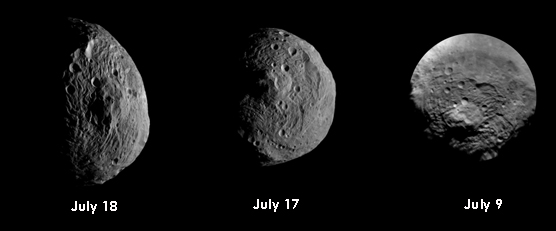NASA's asteroid probe Dawn entered orbit around Vesta at roughly 1:00 a.m. EDT on July 16th. Since then, mission scientists at the Jet Propulsion Lab (JPL) in California have been getting ever closer peeks at the asteroid.
This week alone, the team released two sets of images (on Monday and Thursday) of the 330-mile-wide, oddly-shaped asteroid that orbits in the main asteroid belt between Mars and Jupiter. Taken on July 17th and 18th, when the craft was 9,500 miles and 6,500 miles from Vesta, respectively, these images reveal a bumpy terrain peppered with craters.

This composite image shows the snapshots of Vesta taken using Dawn's framing camera at distances (left to right) of 6,500, 9,500, and 26,000 miles. All three show an intriguing "mountain" in the asteroid's south polar region. Subsequent images are expected to reveal more detail. Click on the image for a larger view.
NASA / JPL / UCLA / MPS / DLR / IDA
A large rocky protuberance in the south polar region of the asteroid had begun to come into focus in images taken on July 9th, a week before Vesta captured Dawn. In this week's images this mountain appears to loom large beside impact craters and steep bluffs on the asteroid.
Scientists are not sure what to call this structure on Vesta's surface yet. In an email to Sky & Telescope planetary scientist, Jim Bell (Arizona State University) said that it is best to use descriptive terms to define features of unknown origin. His personal description would be "a roughly-circular, dome-like hill near the center of what appears to be a large circular, possibly crater-like depression."
The mission's engineers, headed by Marc Rayman, the author of the Dawn Journals, are using these images to steer the craft downward into its science orbit (1,700 miles from the surface), and to calibrate the camera and spectrometer for subsequent imaging.
The craft's wide-angle framing camera, which is currently being used for navigation, will later allow scientists to map the asteroid, Rayman says.
A gallery of Dawn's images allows enthusiasts to follow the mission closely. In upcoming days, Dawn will return more remarkable vistas of Vesta, making the ride more enjoyable.
 5
5
Comments
Michael C. Emmert
July 22, 2011 at 12:27 pm
I guess with Ceres' "promotion to (dwarf) planethood" that would leave Vesta as the largest asteroid. So we get a two for one shot: the largest asteroid and smallest planet. Dawn is a cool machine 🙂
During the great Pluto planet debate one of the criteria considered for the "honor" was whether or not the body was differentiated. Fortunately that was not considered. We would have hundreds of planets to memorize. My Very Eccentric Mom Cut Just Seven Unknown Names ... Wait! I just made a Patrick Geryl style math error!
The "large rocky protuberance" at Vesta's south pole looks to me like a volcano. I guess we'll find out when we start getting some spectral readings back.
You must be logged in to post a comment.
x
July 22, 2011 at 5:54 pm
In the past 21 days, there have been exactly THREE images of Vesta returned from Dawn (at least posted to the official web site). There have also been a few variants of these three scaled up, re-projected, or added to montages. Three photos is not exactly a "barrage", is it? This is a slow-moving mission, of course. Ion thrusters ensure that, and while the Dawn spacecraft did enter orbit around Vesta almost a week ago, it will be a while before it settles into its main mission. It's great to see any images of Vesta. I remember my first peek at Vesta through a small telescope, just a star that moved from one night to the next, about 35 years ago. It's been a long wait, and I'm looking forward to the barrage of images and other observations...
You must be logged in to post a comment.
Hadyn Butler
July 23, 2011 at 12:45 pm
It's remarkable that there are lobate landslip scarps surrounding the south polar impact on Vesta (caused by crater wall gravitational collapse a few minutes after the initial collision). The most obvious scarps can be seen in the three images above - at the 11.30 o'clock position on the July 18 image, the 2 to 3 o'clock position on the July 17 image and from noon to 1 o'clock on the July 9 image - by using the central mountain as the centre of the clock. The central mountain is literally a central uplifted peak (impact rebound). What's of interest to me as a geologist (living inside a 1.85 gigayear crater at Sudbury, Ontario) is how much of the melt sheet was retained in the crater for this weak gravity body? The asteroid belt must have had a lot of Vesta impact splash products at one time.
You must be logged in to post a comment.
Les Gornall
July 24, 2011 at 6:27 am
Great minor planet - but it looks like the Little Prince forgot to clean out the volcano on this one. The engineering team must be delighted with these early results. Firing a bullet to hit a bullet is one thing, but getting your shot captured by the gravity of such a small target is pure genius. This is a great mission!
You must be logged in to post a comment.
Mark W
July 25, 2011 at 11:58 am
My first take on that feature was that it looked like the house getting hit by a snowball. Most of the snow falls off, but a small round lump remains. Maybe a low velocity impact?
You must be logged in to post a comment.
You must be logged in to post a comment.